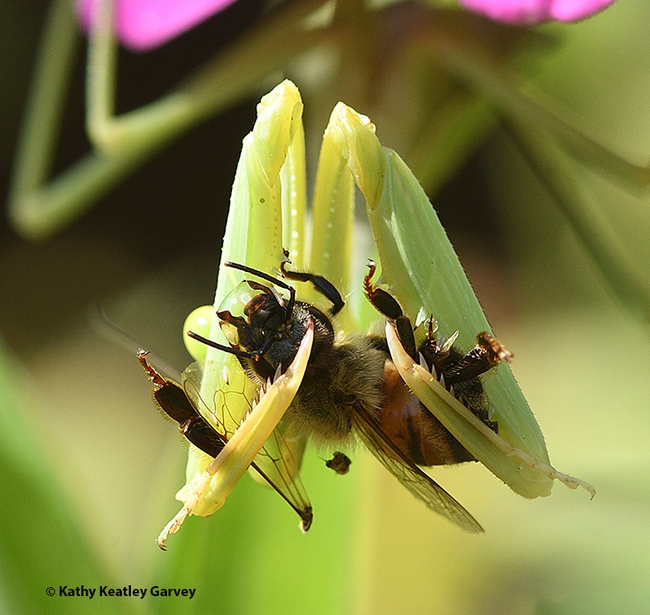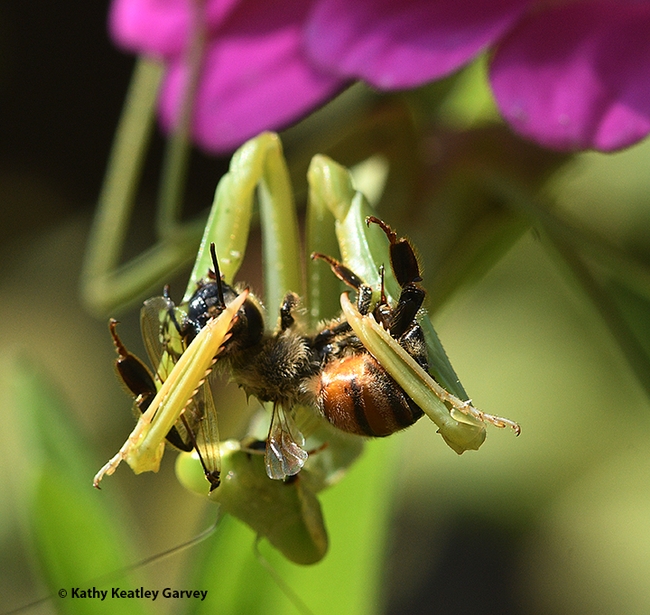- Author: Kathy Keatley Garvey
The katydid nymph did.
It did appear in May.
The UC Statewide Integrated Pest Management Program (UC IPM) tells us that katydid nymphs appear in our gardens in April or May.
This little nymph was right on time, barely, as it surfaced in our Vacaville garden on May 28.
The nymph, a leafeater, is usually so camouflaged in the vegetation that we don't see it--unless it's hanging out on a California golden poppy blossom or a neon pink rock purslane. The adult katydid can be an economic pest when it feeds on such crops as mandarins.
Frankly, it can look quite comical as it "walks the walk," its long threadlike antennae probing the way as it descends a stem in the early evening.
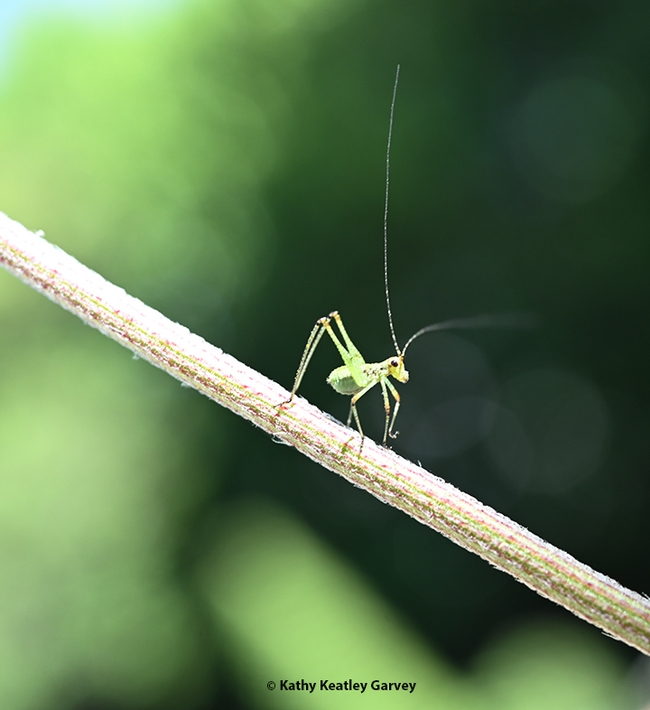
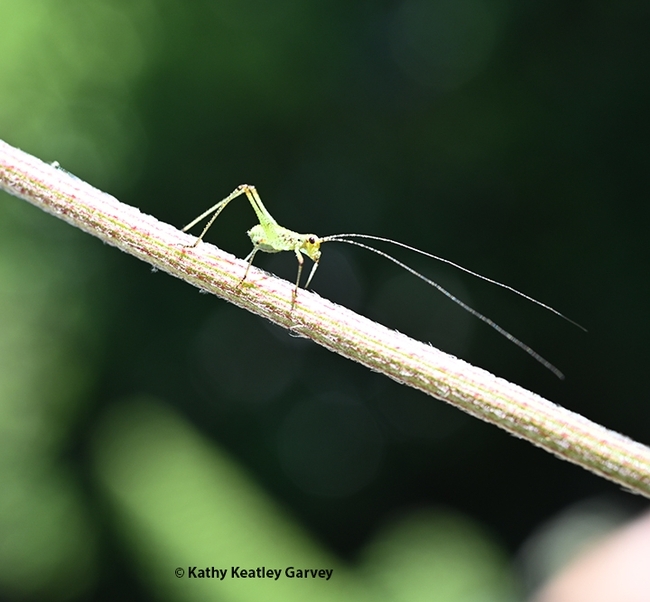
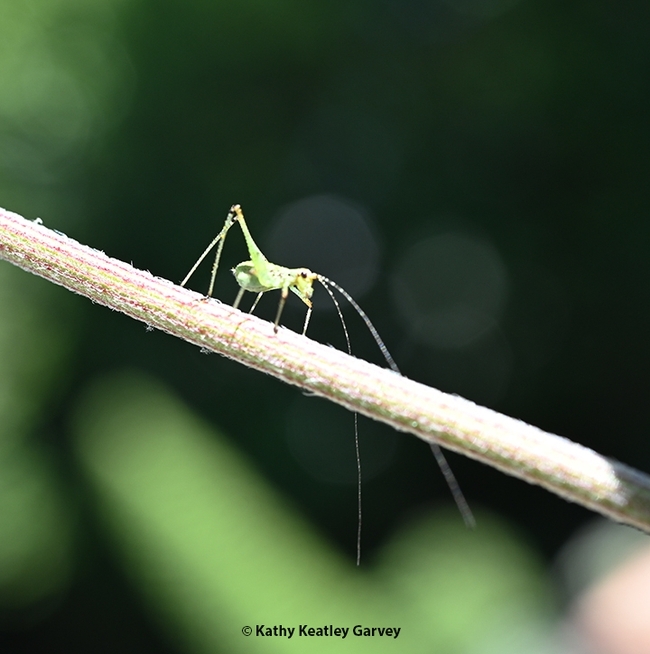
- Author: Kathy Keatley Garvey
Remember when San Francisco 49'ers wide receiver Brandon Aiyuk credited his spectacular 51-yard catch in the 2024 NFC championship game with the Detroit Lions to a ladybug (note that entomologists correctly call it a "lady beetle") landing on his shoe before the game?
Well, those attending the 110th annual UC Davis Picnic Day activities on Saturday, April 20 at Briggs Hall--home of the UC Davis Department of Entomology and Nematology--can also net some luck.
Children are encouraged to take home a couple of the beetles at the UC Statewide Integrated Pest Management Program (UC IPM) booth in the courtyard of Briggs. (Adults can do so, too. Maybe they'll name their beetles "Brandon" and "Aiyuk.")
The ladybug is actually a beetle (Coleoptera), not a bug (Hemiptera). It's associated with good luck because it eats the aphids that try to destroy our crops. It can eat as many as 5000 aphids in its lifetime, scientists estimate.
"These beetles have become a cultural icon of sorts because of their appearance and their beneficial habits," writes UC Davis distinguished professor Lynn Kimsey, former director of the Bohart Museum of Entomology, in her insect fact sheet on lady beetles. "Both adults and larvae feed on aphids and other small, soft-bodied insects...They are ferocious predators on small insects." (See what the UC Statewide Integrated Pest Management Program says about lady beetles.)
Ever seen a close-up shot of a lady beetle eating an aphid? The predator and the prey...
Ever seen a cellar spider snaring and eating a lady beetle? The predator and the predator...one becomes prey.
Ordinarily, the lady beetle's bright red coloration serves as a "warning" to predators. Plus, lady beetles are known to ooze a foul-tasting chemical that tastes so bad that predators leave them alone. This lady beetle engaged in "reflex bleeding," exuding an alkaloid toxin (which did not deter the predator).
Lady beetles will be just a few of the bugs at Briggs Hall during UC Davis Picnic Day. You'll also see cockroach races, maggot art, and displays featuring ants, bees, walking sticks, mosquitoes, nematodes, butterflies, spiders, whip scorpions, and more. Check out "bug" activities at Briggs Hall here. UC Davis Picnic Day is free and family friendly.
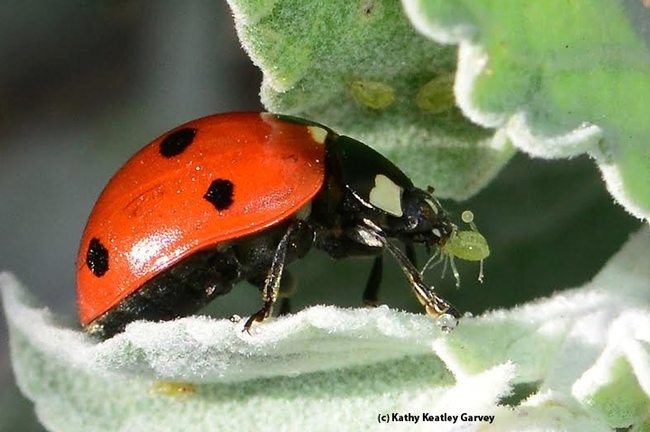
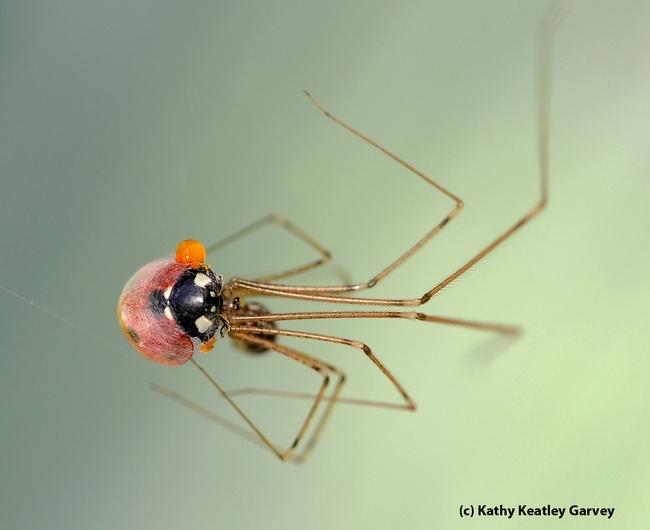
- Author: Kathy Keatley Garvey
You've heard folks call insects "big 'ol bugs" (often in astonishment or terror), right?
But have you ever seen a "bigeyed bug on a monarch butterfly?"
Bigeyed bugs, Geocoris spp., are beneficial insects, "found mostly on low-growing plants, including many field and row crops and in gardens," according to the UC Statewide Integrated Management Program (UC IPM). "Adults and nymphs feed by sucking prey's body contents through their needlelike mouthparts. Bigeyed bugs feed on bug nymphs, flea beetles, insect eggs, small caterpillars, and all stages of aphids, mites, and whiteflies. Bigeyed bugs also feed harmlessly on pollen, seeds, and plant juices and are not plant pests."
And Wikipedia tells us: "Big-eyed bugs, like other true bugs, have piercing-sucking mouthparts and feed by stabbing their prey and sucking or lapping the juices. Although their effectiveness as predators is not well understood, studies have shown that nymphs can eat as many as 1600 spider mites before reaching adulthood, while adults have been reported consuming as many as 80 mites per day."
So, it's Jan. 4, 2024, and here's this bigeyed bug resting in a patch of blanket flowers (Gaillardia) in our Vacaville pollinator garden. Then it's briefly crawling up the wing of a monarch that's nectaring on the flowers. (Yes, fall and winter monarch breeding does occur here in central California, according to butterfly guru Art Shapiro, UC Davis distinguished professor emeritus. He recorded a monarch in flight on Jan. 19, 2020 in Sacramento, but even earlier than that--UC Davis professor Louie Yang of the Department of Entomology and Nematology spotted a monarch flying Jan. 8, 2012 in east Davis. We saw a monarch in flight on Dec. 16, 2023 in Vacaville.)
So, what happened to the bigeyed bug and the monarch butterfly? They vanished. Both of them.
Wings up?
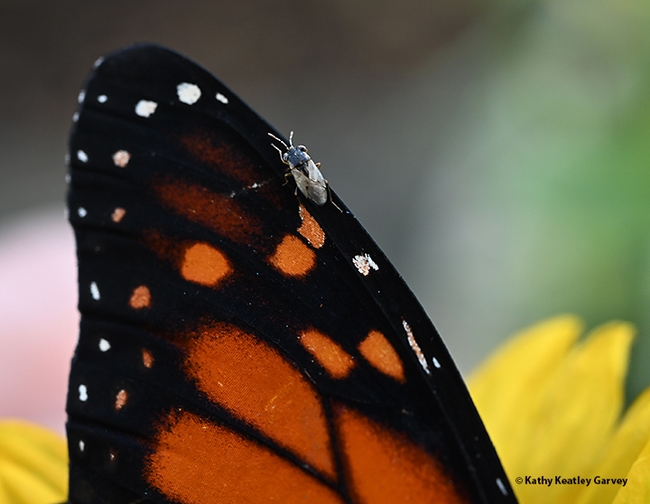
- Author: Kathy Keatley Garvey
Sometimes overlooked as pollinators are the syrphid flies, also known as "hover flies" or "flower flies."
Unfortunately, they are often mistaken for honey bees. Hey, if it's a critter on a flower, it's a bee, right?
Not necessarily!
Syrphid flies are easily distinguished from honey bees. Among the differences: (1) honey bees don't hover, (2) syrphids have only one pair of wings, while honey bees have two (3) syrphids have short, stubby antennae, while honey bees have long, bent antennae called genticulate antennae and (4) syrphids belong to the order Diptera, while honey bees are in the order Hymenoptera.
We spotted this syprhid fly soaking up some early-morning sun It stayed still for a dorsal photo and then sensing danger, slipped under a leaf.
Scientists estimate that there are more than 6200 species of syrphid flies in the world, and more than 3000 in California alone.
The UC Statewide Integrated Pest Management Program (UC IPM) has this to say about syprhids in its Natural Enemies Gallery post: "Adults are robust to slender flies 1/8 to 1 inch (4–25 mm) long, varying by species. The broad head is about the width of the abdomen or wider and has large eyes with distinct antennae. The body of many adults is black with bands or stripes of orange, yellow, or white, resembling stinging bees or wasps. Some species are mostly brown, metallic blue or green, yellow, or combinations of these or other colors. For example, adults of ant-predaceous Microdon species are blackish to brown or bright to dark greenish."
Many syrphids prey on aphids and mealybugs, so they're good guys and gals to have in your garden.
Says UC IPM: "Most species are predaceous, most commonly on aphids or mealybugs. Some syrphids prey on ants, caterpillars, froghoppers, psyllids, scales, other insects, or mites."
The good guys and gals of the garden...
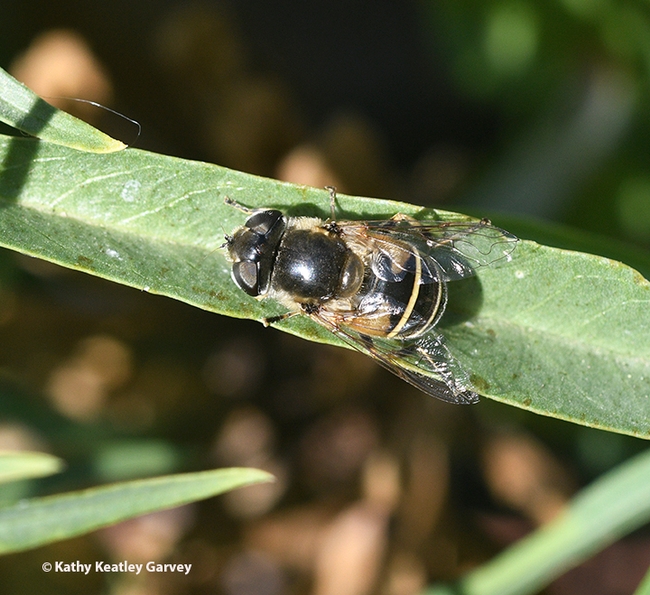
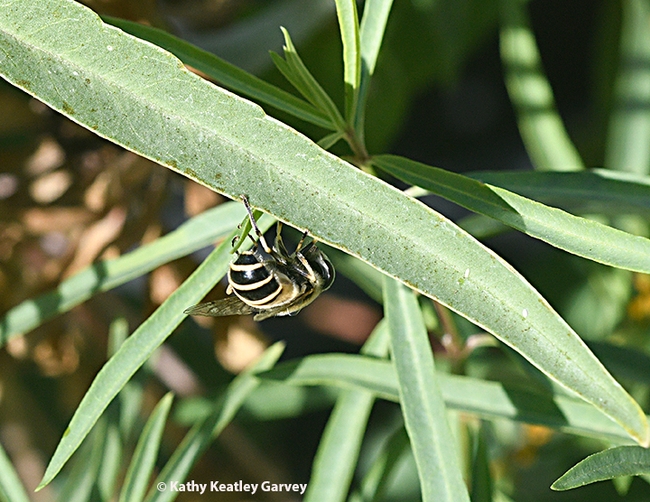
- Author: Kathy Keatley Garvey
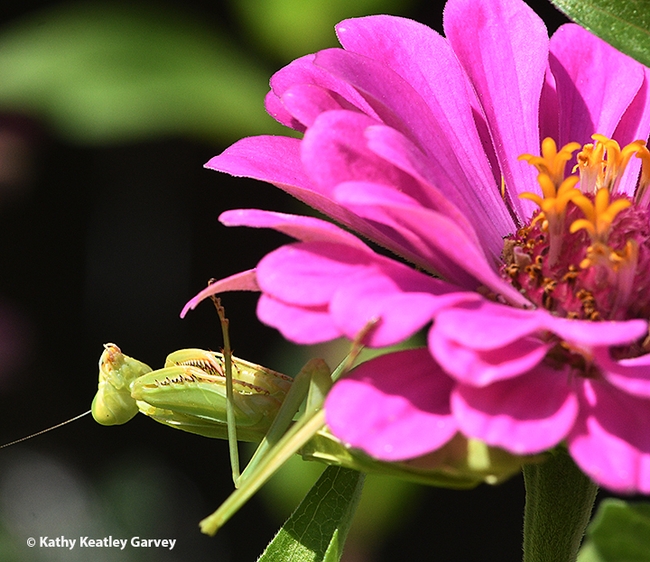
Often it's so camouflaged that it totally blends in with its habitat. It can rotate its head 180 degrees--and nothing, it seems, can escape its view.
Praying mantises are not considered biological pest control agents because basically they'll eat anything they can catch: from your favorite pollinators (bees and butterflies) to your favorite beneficial insects (lady beetles and assassin bugs), your favorite bird (hummingbird) to pests (stink bugs and lygus bugs) to syrphid flies, green bottle flies, and wandering caterpillars that happen to cross its path.
And they'll eat one another...catch me if you can!
Truly, they are not picky eaters like little humans who scowl at a food, push it around their plates, or "accidentally" drop it on the floor for the dog to grab.
"Over 2,000 mantid species occur in the world, mostly in tropical and subtropical regions," according to the UC Statewide Integrated Pest Program (UC IPM). "At least 9 mantid species occur in California. The Arizona or bordered mantid (Stagmomantis limbata), Bistanta mexicana, California mantid (Stagmomantis wheeleri =S. californica), Litaneutria ocularis =Litaneutria obscura, and small gray mantid (Litaneutria pacifica) are native species. Chinese mantid (Tenodera sinensis), European mantid (Mantis religiosa), Mediterranean mantid (Iris oratoria), and South African mantid (Miomantis caffra) are introduced."
"Mantids (mantises) are among the largest insects," UC IPM says. "Adults generally range from 2 to 5 inches (5–12 cm) long. Adults and nymphs (immatures) are elongate and usually brown, green, or yellowish; a single species can have all 3 color phases, such as the California mantid, Stagmomantis wheeleri =S. californica."
A mantis has two spiked forelegs that enable it to grasp and subdue its prey. It's a death grip...or a dinner grip...Ever seen a praying mantis "cradle" its prey?
This mantis, below, is a Stagmomantis limbata. Dinner was a bee. Earlier it preyed on a green bottle fly.
